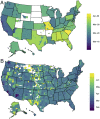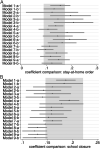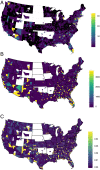Measuring voluntary and policy-induced social distancing behavior during the COVID-19 pandemic
- PMID: 33820846
- PMCID: PMC8076999
- DOI: 10.1073/pnas.2008814118
Measuring voluntary and policy-induced social distancing behavior during the COVID-19 pandemic
Abstract
Staying home and avoiding unnecessary contact is an important part of the effort to contain COVID-19 and limit deaths. Every state in the United States enacted policies to encourage distancing and some mandated staying home. Understanding how these policies interact with individuals' voluntary responses to the COVID-19 epidemic is a critical initial step in understanding the role of these nonpharmaceutical interventions in transmission dynamics and assessing policy impacts. We use variation in policy responses along with smart device data that measures the amount of time Americans stayed home to disentangle the extent that observed shifts in staying home behavior are induced by policy. We find evidence that stay-at-home orders and voluntary response to locally reported COVID-19 cases and deaths led to behavioral change. For the median county, which implemented a stay-at-home order with about two cases, we find that the response to stay-at-home orders increased time at home as if the county had experienced 29 additional local cases. However, the relative effect of stay-at-home orders was much greater in select counties. On the one hand, the mandate can be viewed as displacing a voluntary response to this rise in cases. On the other hand, policy accelerated the response, which likely helped reduce spread in the early phase of the pandemic. It is important to be able to attribute the relative role of self-interested behavior or policy mandates to understand the limits and opportunities for relying on voluntary behavior as opposed to imposing stay-at-home orders.
Keywords: COVID-19; avoidance behavior; nonpharmaceutical interventions; social distancing; stay-at-home order.
Conflict of interest statement
The authors declare no competing interest.
Figures






Comment in
- doi: 10.1073/pnas.2104413118
References
-
- Budryk Z., North Dakota records world’s highest COVID-19 mortality rate. The Hill, https://thehill.com/policy/healthcare/526324-north-dakota-records-worlds.... Accessed 17 November 2020.
-
- Dake L., Oregon leaders want you to follow new COVID-19 rules. But don’t expect a knock on the door. OPB,. https://www.opb.org/article/2020/11/18/oregon-leaders-want-you-to-follow.... Accessed 18 November 2020.
-
- BallotPedia , Lawsuits about state actions and policies in response to the coronavirus (COVID-19) pandemic. https://ballotpedia.org/Lawsuits_about_state_actions_and_policies_in_res.... Accessed 19 November 2020.
-
- National Academies of Sciences, Engineering, and Medicine , Framework for Equitable Allocation of COVID-19 Vaccine (The National Academies Press, Washington, DC, 2020). - PubMed
Publication types
MeSH terms
Grants and funding
LinkOut - more resources
Full Text Sources
Other Literature Sources
Medical

